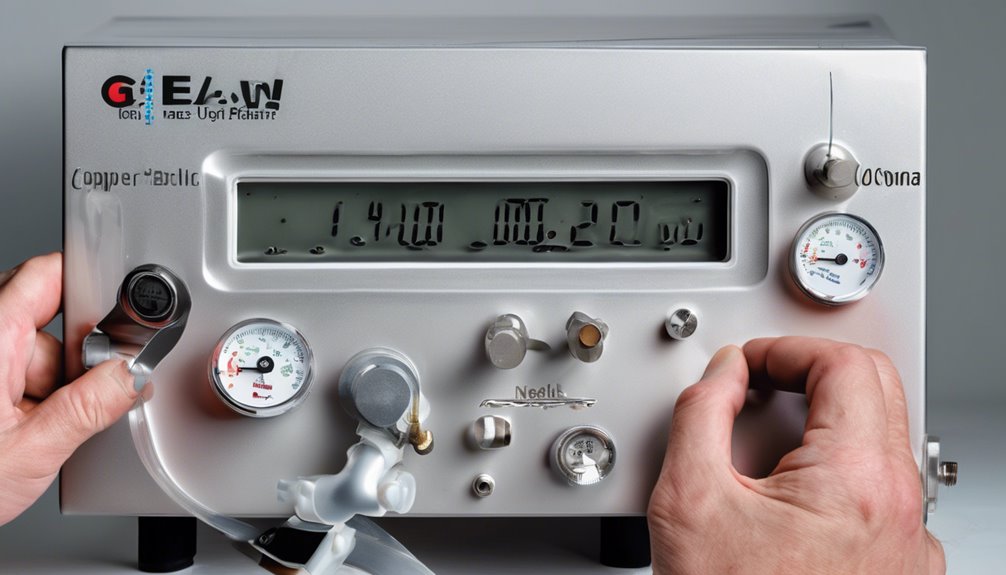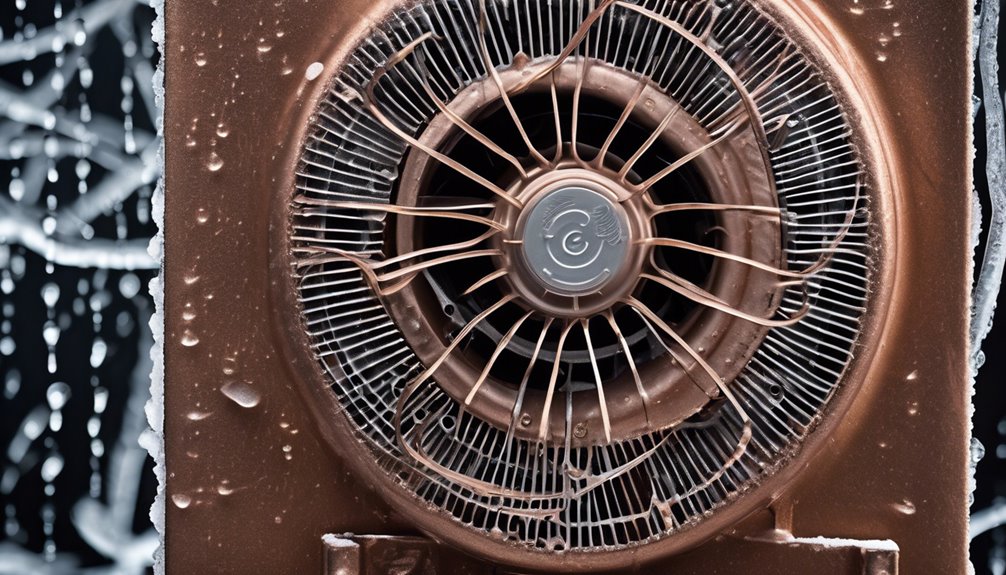To check your air conditioner's gas pressure, you'll need a manifold gauge set with a low-side gauge, high-side gauge, and manifold. Locate the low-side port, usually on the larger copper line connected to the compressor, and attach the pressure gauge securely. Take multiple readings, ensuring the connection is tight to avoid false readings. Compare the pressure to the corresponding range for your AC's refrigerant type, and look out for signs of leaking refrigerant or other issues. Want to learn more about how to diagnose and fix potential problems?
Key Takeaways
- Locate the low-side port on the air conditioning unit's compressor, usually the larger of the two copper lines, and consult the service manual for specific port location.
- Attach the pressure gauge to the low-side port securely, ensuring a tight connection to prevent false readings, and verify the gas gauge calibration.
- Take multiple pressure readings, allowing gas levels to settle, and record the reading for future reference, using the correct unit of measurement (e.g., PSI or BAR).
- Compare the reading to the corresponding range for the AC's refrigerant type (e.g., R-22, R-410A, or R-134a) and look out for signs of leaking refrigerant, such as ice buildup or hissing sounds.
- Monitor system parameters, including pressures, temperatures, and flow rates, to detect anomalies and identify potential issues affecting the AC's performance.
Gathering Essential Tools and Equipment
You'll need a few essential tools and equipment to check the AC gas pressure safely and accurately.
Proper tool selection is crucial to ensure you get reliable readings. Start by gathering a manifold gauge set, which typically includes a low-side gauge, high-side gauge, and a manifold.
Proper tool selection is crucial for reliable readings, starting with a manifold gauge set featuring low-side, high-side, and manifold gauges.
This set will help you measure the pressure and diagnose any issues. Next, inspect your equipment to ensure it's in good working condition.
Check for any signs of damage, wear, or corrosion on the hoses, fittings, and gauges. Make sure all connections are secure and won't leak during the test.
Locating the Low-Side Port
The low-side port is usually located on the larger of the two copper lines connected to the air conditioning unit's compressor.
You'll need to consult your air conditioner's service manual to determine the exact port location for your specific model.
To ensure you're looking at the right spot, keep the following in mind:
- The low-side port is typically larger than the high-side port.
- It's often labeled as "Low" or "Suction" on the compressor.
- The port is usually schrader valve type, similar to a car tire valve stem.
- It may be covered with a plastic cap or valve stem cap to protect it from debris.
Remember to identify the correct port to avoid incorrect pressure readings or damage to your AC system.
Attaching the Pressure Gauge
Attach the pressure gauge to the low-side port by removing the valve stem cap and threading the gauge hose onto the schrader valve.
Make sure the connection is secure and tight to ensure accurate attachment. A loose connection can lead to false readings, so double-check the hose for any signs of wear or damage.
Before taking a reading, verify that your gas gauge calibration is up to date to ensure the accuracy of your results.
Proper attachment is crucial, as it directly affects the reliability of your pressure reading. Take your time and attach the gauge correctly to get an accurate measurement of your AC gas pressure.
Taking the Pressure Reading
How accurately can you trust your pressure reading? You've attached the gauge, now it's time to take the reading.
Make sure the valve is fully open to get an accurate measurement. If the pressure reading is fluctuating, wait for a few seconds to allow the gas levels to stabilize.
Here are some key factors to keep in mind when taking the pressure reading:
- Stabilize the pressure: Allow the gas levels to settle before taking the reading.
- Take multiple readings: Take multiple readings to ensure accuracy and account for any minor pressure fluctuations.
- Use the correct unit: Ensure the gauge is set to the correct unit of measurement (e.g., PSI or BAR).
- Record the reading: Write down the reading for future reference and comparison.
Understanding the Pressure Gauge Readings
Your pressure gauge reading is in hand, but what does it mean? Understanding the pressure gauge readings is crucial to determining if your AC is functioning properly. The reading will indicate the pressure level of the refrigerant in your AC system.
| Gas Type | Pressure Range |
|---|---|
| R-22 | 65-85 psi |
| R-410A | 115-145 psi |
| R-134a | 35-55 psi |
You'll notice that different gas types have unique pressure ranges. Compare your reading to the corresponding range for your AC's refrigerant type. If the reading falls within the recommended range, your AC is likely functioning normally. Remember to consult your AC's manual for specific guidance on pressure ranges and gas types.
Identifying Potential Issues
As you inspect your AC's gas pressure, you'll want to identify potential issues that could be affecting its performance.
Look out for signs of leaking refrigerant, such as ice buildup or hissing sounds, as well as symptoms of low pressure, like reduced airflow or increased energy bills.
Leaking Refrigerant Signs
Refrigerant leaks can be a silent killer of your air conditioner's performance and efficiency.
You may not even notice a problem until it's too late. That's why it's essential to identify the signs of leaking refrigerant early on.
If you're experiencing refrigerant loss or gas leakage, your AC's performance will suffer, and your energy bills will skyrocket.
- Increased energy bills: If your energy bills are higher than usual, it could be a sign that your AC is working harder to cool your space due to refrigerant loss.
- Ice buildup: Ice or frost on your AC's coils or pipes indicates that refrigerant is leaking, causing the system to work less efficiently.
- Hissing sounds: Unusual hissing or bubbling sounds from your AC could indicate a refrigerant leak.
- Reduced airflow: If the airflow from your AC vents is weaker than usual, it might be a sign of refrigerant leakage.
Low Pressure Symptoms
Now that you're aware of the signs of refrigerant leaks, it's time to explore the potential issues associated with low gas pressure in your air conditioner. Low gas pressure can lead to cold symptoms, such as reduced cooling performance or uneven cooling. If left unchecked, it can even cause system failure.
| Symptoms | Description | Impact |
|---|---|---|
| Reduced Cooling | Insufficient cooling or warm air blowing | Inconsistent temperatures |
| Increased Energy Bills | Higher energy consumption due to inefficient cooling | Increased costs |
| Unusual Noises | Gurgling, hissing, or bubbling sounds from the AC unit | Potential system damage |
System Performance Impact
When your air conditioner's gas pressure drops, it can trigger a ripple effect that impacts system performance in various ways.
You'll likely notice a decline in system efficiency, leading to increased energy bills and reduced cooling capacity.
Reduced cooling capacity, increased energy bills, compressor damage, and system failure are all potential issues you may encounter:
- Reduced Cooling Capacity: Your AC won't be able to cool your space as effectively, making it uncomfortable and even unbearable during hot summer days.
- Increased Energy Bills: With reduced system efficiency, your AC will consume more power, leading to higher energy bills and increased costs.
- Compressor Damage: Prolonged low gas pressure can cause compressor damage, resulting in costly repairs or even replacement.
- System Failure: In extreme cases, low gas pressure can lead to complete system failure, leaving you without a functioning AC during the hottest months.
Performing Additional Checks
You'll want to perform additional checks to ensure your AC system is running efficiently and safely.
Next, you'll need to detect any system leaks that could be causing the pressure issues, and then test the pressure gauge to ensure it's providing accurate readings.
System Leaks Detection
How sensitive are you to the slightest hiss of escaping refrigerant?
When it comes to system leaks detection, you need to be thorough. A single leak can compromise the entire AC system, leading to reduced performance and increased energy bills.
During system diagnosis, you'll want to perform the following checks:
- Inspect connections: Look for signs of wear, corrosion, or damage on fittings, valves, and hoses.
- Use a leak detector: Employ a refrigerant leak detector to identify areas with refrigerant leaks.
- Check for oil stains: Oil stains around connections or components can indicate a refrigerant leak.
- Monitor system performance: Keep an eye on system pressures, temperatures, and flow rates to detect any anomalies.
Pressure Gauge Testing
With your system leaks detection complete, it's time to dig deeper and perform additional checks using pressure gauge testing.
You'll want to ensure your gauge is properly calibrated using gauge calibration methods to get accurate readings. This is crucial for effective gas leak detection.
Attach the gauge to the AC system and take readings at different points. Compare these readings to the manufacturer's specifications to identify any deviations.
If you notice a significant drop in pressure, it may indicate a gas leak. Use the gauge to isolate the leak and make necessary repairs.
Frequently Asked Questions
Can I Check AC Gas Pressure With the Compressor Running?
You shouldn't check AC gas pressure with the compressor running, as it can cause system malfunctions and pressure fluctuations, leading to inaccurate readings and potentially damaging your AC unit.
How Often Should I Check AC Gas Pressure?
You should make routine maintenance a habit, including seasonal checks, to ensure your AC runs efficiently and effectively. For optimal performance, it's recommended to check the gas pressure every 6-12 months, or as specified in your AC's manual.
What Is the Ideal AC Gas Pressure for My Unit?
You'll want to know the ideal AC gas pressure for your unit, which depends on the refrigerant type. Typically, R-410A ranges from 70-120 PSI, while R-22 is between 60-100 PSI; always consult your unit's manual for specific pressure ranges.
Can I Use a Tire Pressure Gauge for AC Gas Pressure?
You can't use a tire pressure gauge for AC gas pressure, as it's not designed for high-pressure refrigerant systems and can cause gas leakage; instead, invest in a gauge compatible with your AC unit's specifications.
Will Low AC Gas Pressure Cause My Electricity Bill to Rise?
You'll likely see a spike in your electricity bill if your AC's gas pressure is too low, as it reduces cooling efficiency and increases energy consumption, making your system work harder to cool your space.
Conclusion
You've successfully checked your AC's gas pressure! Now you're equipped to identify potential issues and take corrective action. Remember to regularly check the pressure to ensure your AC runs efficiently and effectively. By following these steps, you'll be able to diagnose and fix problems before they become major issues. Stay on top of your AC's maintenance to enjoy a cool and comfortable living space.



